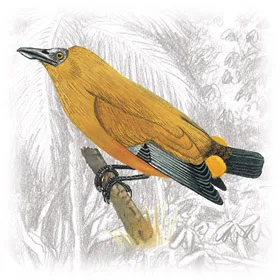
Capuchinbird
[order] Passeriformes | [family] Cotingidae | [latin] Perissocephalus tricolor | [UK] Capuchinbird | [FR] Coracine chauve | [DE] Kapuzinerkotinga | [ES] Pajaro-capuchino | [IT] Uccello cappuccino | [NL] Capuchonvogel
Subspecies
| Genus | Species | subspecies | Breeding Range | Breeding Range 2 | Non Breeding Range |
| Cephalopterus | tricolor | ||||
| Perissocephalus | tricolor | SA | ne Amazonia |
Physical charateristics
Crown and sided of the head are bare and darkk bkue-grey. The nape and the upper mantle cinnamon-brown becoming more reddish brown on the lower back. Wings are blackm wing coverts brown and the under wing coverts white. Tail black, throat and upper breast cinnamon-brown, rest of under parts chestnut rufous. Sexes are alike with upper mandible black and lower grey.
Listen to the sound of Capuchinbird
[audio:http://www.aviflevoland.nl/sounddb/C/Capuchinbird.mp3]
Copyright remark: Most sounds derived from xeno-canto
| wingspan min.: | 0 | cm | wingspan max.: | 0 | cm |
| size min.: | 34 | cm | size max.: | 35 | cm |
| incubation min.: | 26 | days | incubation max.: | 27 | days |
| fledging min.: | 0 | days | fledging max.: | 0 | days |
| broods: | 1 | eggs min.: | 1 | ||
| eggs max.: | 1 |
Range
It is found in Brazil, Colombia, French Guiana, Guyana, Suriname, and Venezuela.
Habitat
Its natural habitat is subtropical or tropical moist lowland forests.
Reproduction
The Capuchin bird forms leks around a dominant male and his subordinates trying to occupy the dominant male’s perch. They are very loud during their display and the noise has been compared with the mooing of a cow. Nest is a small open cup made out of twigs. It is usually built 3-6 meter above ground in understorey tree. Clutch size is one egg incubatedsfor about 26-27 days.
Feeding habits
Forages in the forest understorey and low level brachnes for fruit. Takes this by pervhing and eating or plucking wit hshort sallies. Also hunts large insects, taken by short flights through the foliage and gleaning prey from leafs.
Conservation
This species has a large range, with an estimated global extent of occurrence of 1,700,000 km². The global population size has not been quantified, but the species is not believed to approach the thresholds for the population size criterion of the IUCN Red List (i.e., less than 10,000 mature individuals in conjunction with appropriate decline rates and subpopulation qualifiers), even though the species is described as ‘uncommon’ in at least parts of its range (Stotz et al. 1996). Global population trends have not been quantified, but the species is not believed to approach the thresholds for the population decline criterion of the IUCN Red List (i.e., declining more than 30% in ten years or three generations). For these reasons, the species is evaluated as Least Concern.

Migration
Sedentary throughout range.
Distribution map

]]>
